A Vaccine Strain of the A/ASIA/Sea-97 Lineage of Foot-and-Mouth Disease Virus with a Single Amino Acid Substitution in the P1 Region That Is Adapted to Suspension Culture Provides High Immunogenicity
Abstract
1. Introduction
2. Materials and Methods
2.1. Cells and Viruses
2.2. Serial Passaging of FMDV and Virus Plaque Purification
2.3. Infectivity Tests in CHO-K1 and BHK-21 Adherent Cells
2.4. Genome Amplification, Nucleotide Sequencing, and Amino Acid Sequence Alignment
2.5. Production of Inactivated Antigen
2.6. Vaccination of Pigs and Cows for Serology Test
2.7. VNTs for Homologous and Heterologous Viruses
2.8. Vaccine Matching by 2D VNT
2.9. Vaccination of C57BL/6 Mice and Challenge with Heterologous FMDV
2.10. Assessment of Early Protection in Pigs Vaccinated with the A/SKR/Yeoncheon/2017(A-1)
2.10.1. Vaccination and FMDV Challenge
2.10.2. Blood Sampling and Analysis
2.11. Statistical Analysis
3. Results
3.1. Virus Adaptation to BHK-21 Suspension Cells over Serial Passages
3.2. Comparison of Receptor Usage and Amino Acid Substitutions in the P1 Region in Plaque-Purified Viruses
3.3. Qualification of A/SKR/Yeoncheon/2017 (A-1) Virus for Vaccine Production
3.4. Neutralizing Antibody Response after Immunization with A/SKR/Yeoncheon/2017 Experimental Vaccine for Homologous and Heterologous Viruses in Pigs
3.5. Vaccine Matching Using Vaccinated Cow Sera
3.6. Heterologous Virus Challenge in Vaccinated Mice
3.7. Early Protection in Pigs Injected with the A/SKR/Yeoncheon/2017 (A-1) Experimental Vaccine
4. Discussion
5. Conclusions
Author Contributions
Funding
Institutional Review Board Statement
Informed Consent Statement
Data Availability Statement
Acknowledgments
Conflicts of Interest
References
- Alexandersen, S.; Zhang, Z.; Donaldson, A.; Garland, A. The Pathogenesis and Diagnosis of Foot-and-Mouth Disease. J. Comp. Pathol. 2003, 129, 1–36. [Google Scholar] [CrossRef]
- Moraes, M.P.; Santos, T.D.L.; Koster, M.; Turecek, T.; Wang, H.; Andreyev, V.G.; Grubman, M.J. Enhanced Antiviral Activity against Foot-and-Mouth Disease Virus by a Combination of Type I and II Porcine Interferons. J. Virol. 2007, 81, 7124–7135. [Google Scholar] [CrossRef] [PubMed]
- Paton, D.J.; Valarcher, J.F.; Bergmann, I.; Matlho, O.G.; Zakharov, V.M.; Palma, E.L.; Thomson, G.R. Selection of foot and mouth disease vaccine strains—A review. Rev. Sci. Tech. l’OIE 2005, 24, 981–993. [Google Scholar] [CrossRef]
- Knowles, N.; Samuel, A. Molecular epidemiology of foot-and-mouth disease virus. Virus Res. 2003, 91, 65–80. [Google Scholar] [CrossRef]
- Parida, S. Vaccination against foot-and-mouth disease virus: Strategies and effectiveness. Expert Rev. Vaccines 2009, 8, 347–365. [Google Scholar] [CrossRef]
- Mahapatra, M.; Statham, B.; Li, Y.; Hammond, J.; Paton, D.; Parida, S. Emergence of antigenic variants within serotype A FMDV in the Middle East with antigenically critical amino acid substitutions. Vaccine 2016, 34, 3199–3206. [Google Scholar] [CrossRef] [PubMed]
- Brehm, K.; Kumar, N.; Thulke, H.-H.; Haas, B. High potency vaccines induce protection against heterologous challenge with foot-and-mouth disease virus. Vaccine 2008, 26, 1681–1687. [Google Scholar] [CrossRef]
- Country Repots. Available online: http://www.wrlfmd.org/country-reports (accessed on 4 March 2021).
- Bankowska, K. FAO World Reference Laboratory for Foot-and-Mouth Disease (WRLFMD) Genotyping Report; Woking GU24 0NF; The Pirbright Institute: Pirbright, UK, 2017.
- Amadori, M.; Volpe, G.; Defilippi, P.; Berneri, C. Phenotypic Features of BHK-21 Cells Used for Production of Foot-and-mouth Disease Vaccine. Biologicals 1997, 25, 65–73. [Google Scholar] [CrossRef]
- Dill, V.; Eschbaumer, M. Cell culture propagation of foot-and-mouth disease virus: Adaptive amino acid substitutions in structural proteins and their functional implications. Virus Genes 2020, 56, 1–15. [Google Scholar] [CrossRef]
- Sa-Carvalho, D.; Rieder, E.; Baxt, B.; Rodarte, R.; Tanuri, A.; Mason, P.W. Tissue culture adaptation of foot-and-mouth disease virus selects viruses that bind to heparin and are attenuated in cattle. J. Virol. 1997, 71, 5115–5123. [Google Scholar] [CrossRef]
- Mohapatra, J.K.; Pandey, L.K.; Rai, D.K.; Das, B.; Rodriguez, L.L.; Rout, M.; Subramaniam, S.; Sanyal, A.; Rieder, E.; Pattnaik, B. Cell culture adaptation mutations in foot-and-mouth disease virus serotype A capsid proteins: Implications for receptor interactions. J. Gen. Virol. 2015, 96, 553–564. [Google Scholar] [CrossRef]
- Fry, E.E.; Newman, J.W.I.; Curry, S.; Najjam, S.; Jackson, T.; Blakemore, W.; Lea, S.M.; Miller, L.; Burman, A.; King, A.M.Q.; et al. Structure of Foot-and-mouth disease virus serotype A1061 alone and complexed with oligosaccharide receptor: Receptor conservation in the face of antigenic variation. J. Gen. Virol. 2005, 86, 1909–1920. [Google Scholar] [CrossRef] [PubMed]
- Baxt, B.; Vakharia, V.; Moore, D.M.; Franke, A.J.; Morgan, D.O. Analysis of neutralizing antigenic sites on the surface of type A12 foot-and-mouth disease virus. J. Virol. 1989, 63, 2143–2151. [Google Scholar] [CrossRef] [PubMed]
- Tami, C.; Taboga, O.; Berinstein, A.; Núñez, J.I.; Palma, E.L.; Domingo, E.; Sobrino, F.; Carrillo, E. Evidence of the Coevolution of Antigenicity and Host Cell Tropism of Foot-and-Mouth Disease Virus In Vivo. J. Virol. 2003, 77, 1219–1226. [Google Scholar] [CrossRef]
- Pay, T.; Hingley, P. Foot and mouth disease vaccine potency test in cattle: The interrelationship of antigen dose, serum neutralizing antibody response and protection from challenge. Vaccine 1992, 10, 699–706. [Google Scholar] [CrossRef]
- LaRocco, M.; Krug, P.W.; Kramer, E.; Ahmed, Z.; Pacheco, J.M.; Duque, H.; Baxt, B.; Rodriguez, L.L. A continuous bovine kidney cell line constitutively expressing bovine αVβ6 integrin has increased susceptibility to foot-and-mouth disease virus. J. Clin. Microbiol. 2015, 53, 755. [Google Scholar] [CrossRef]
- Lewis, A.M., Jr.; Rowe, W.P. Isolation of two plaque variants from the adenovirus type 2-simian virus 40 hybrid population which differ in their efficiency in yielding simian virus 40. J. Virol. 1970, 5, 413–420. [Google Scholar] [CrossRef] [PubMed]
- Reed, L.J.; Muench, H. A simple method of estimating fifty percent end points. Am. J. Hyg. 1938, 27, 7. [Google Scholar]
- Lawrence, P.; Larocco, M.; Baxt, B.; Rieder, E. Examination of soluble integrin resistant mutants of foot-and-mouth disease virus. Virol. J. 2013, 10, 2. [Google Scholar] [CrossRef]
- Baranowski, E.; Ruiz-Jarabo, C.M.; Sevilla, N.; Andreu, D.; Beck, E.; Domingo, E. Cell Recognition by Foot-and-Mouth Disease Virus That Lacks the RGD Integrin-Binding Motif: Flexibility in Aphthovirus Receptor Usage. J. Virol. 2000, 74, 1641–1647. [Google Scholar] [CrossRef]
- Thompson, J.D.; Higgins, D.G.; Gibson, T.J. CLUSTAL W: Improving the sensitivity of progressive multiple sequence alignment through sequence weighting, position-specific gap penalties and weight matrix choice. Nucleic Acids Res. 1994, 22, 4673–4680. [Google Scholar] [CrossRef] [PubMed]
- Ko, M.-K.; Jo, H.-E.; Choi, J.-H.; You, S.-H.; Shin, S.H.; Jo, H.; Lee, M.-J.; Kim, S.-M.; Kim, B.; Park, J.-H.; et al. Chimeric vaccine strain of type O foot-and-mouth disease elicits a strong immune response in pigs against ME-SA and SEA topotypes. Veter-Microbiol. 2019, 229, 124–129. [Google Scholar] [CrossRef] [PubMed]
- Barteling, S.J.; Meloen, R.H. A simple method for the quantification of 140 s particles of foot-and-mouth disease virus (FMDV). Arch. Virol. 1974, 45, 362–364. [Google Scholar] [CrossRef]
- Jo, H.-E.; Ko, M.-K.; Choi, J.-H.; Shin, S.H.; Jo, H.; You, S.-H.; Lee, M.J.; Kim, S.-M.; Kim, B.; Park, J.-H. New foot-and-mouth disease vaccine, O JC-R, induce complete protection to pigs against SEA topotype viruses occurred in South Korea, 2014–2015. J. Veter-Sci. 2019, 20, e42. [Google Scholar] [CrossRef] [PubMed]
- OIE. Manual of Diagnostic Tests and Vaccines for Terrestrial Animals, Chapter 3.1.8. Foot-and-Mouth. Available online: http://www.oie.int/fileadmin/Home/eng/Health_standards/tahm/3.01.08_FMD.pdf (accessed on 21 January 2021).
- Choi, J.-H.; Ko, M.-K.; Shin, S.H.; You, S.-H.; Jo, H.-E.; Jo, H.; Lee, M.J.; Kim, S.-M.; Lee, J.-S.; Kim, B.; et al. Improved foot-and-mouth disease vaccine, O TWN-R, protects pigs against SEA topotype virus occurred in South Korea. Veter-Microbiol. 2019, 236, 108374. [Google Scholar] [CrossRef]
- Kim, S.-M.; Lee, K.-N.; Lee, S.-J.; Ko, Y.-J.; Lee, H.-S.; Kweon, C.-H.; Kim, H.-S.; Park, J.-H. Multiple shRNAs driven by U6 and CMV promoter enhances efficiency of antiviral effects against foot-and-mouth disease virus. Antivir. Res. 2010, 87, 307–317. [Google Scholar] [CrossRef]
- Kim, S.-M.; Park, J.-H.; Lee, K.-N.; Kim, S.-K.; You, S.-H.; Kim, T.; Tark, D.; Lee, H.-S.; Seo, M.-G.; Kim, B. Robust Protection against Highly Virulent Foot-and-Mouth Disease Virus in Swine by Combination Treatment with Recombinant Adenoviruses Expressing Porcine Alpha and Gamma Interferons and Multiple Small Interfering RNAs. J. Virol. 2015, 89, 8267–8279. [Google Scholar] [CrossRef]
- Foot-and-Mouth Disease Quarterly Report (April-June 2020): Fast Reports: Foot-and-Mouth and Similar Transboundary Animal Diseases; Food and Agriculture Organization of the United Nations (FAO): Rome, Italy, 2020; p. 13.
- The Global FMD Situation. Available online: https://rr-asia.oie.int/wp-content/uploads/2020/02/1-2-globla-fmd-situation.pdf (accessed on 4 March 2021).
- Reeve, R.; Borley, D.W.; Maree, F.F.; Upadhyaya, S.; Lukhwareni, A.; Esterhuysen, J.J.; Harvey, W.T.; Blignaut, B.; Fry, E.E.; Parida, S.; et al. Tracking the Antigenic Evolution of Foot-and-Mouth Disease Virus. PLoS ONE 2016, 11, e0159360. [Google Scholar] [CrossRef]
- Curry, S.; Fry, E.; Blakemore, W.; Abu-Ghazaleh, R.; Jackson, T.; King, A.; Lea, S.; Newman, J.; Rowlands, D.; Stuart, D. Per-turbations in the surface structure of A22 Iraq foot-and-mouth disease virus accompanying coupled changes in host cell specificity and antigenicity. Structure 1996, 4, 135–145. [Google Scholar] [CrossRef]
- Pandey, L.K.; Mohapatra, J.K.; Subramaniam, S.; Sanyal, A.; Pande, V.; Pattnaik, B. Evolution of serotype A foot-and-mouth disease virus capsid under neutralizing antibody pressure in vitro. Virus Res. 2014, 181, 72–76. [Google Scholar] [CrossRef]
- Zhao, Q.; Pacheco, J.M.; Mason, P.W. Evaluation of Genetically Engineered Derivatives of a Chinese Strain of Foot-and-Mouth Disease Virus Reveals a Novel Cell-Binding Site Which Functions in Cell Culture and in Animals. J. Virol. 2003, 77, 3269–3280. [Google Scholar] [CrossRef]
- Anil, K.; Sreenivasa, B.; Mohapatra, J.; Hosamani, M.; Kumar, R.; Venkataramanan, R. Sequence analysis of capsid coding region of foot-and-mouth disease virus type A vaccine strain during serial passages in BHK-21 adherent and suspension cells. Biologicals 2012, 40, 426–430. [Google Scholar] [CrossRef]
- Fry, E.E.; Lea, S.M.; Jackson, T.; Newman, J.W.; Ellard, F.M.; Blakemore, W.E.; Abu-Ghazaleh, R.; Samuel, A.; King, A.M.; Stuart, D.I. The structure and function of a foot-and-mouth disease virus-oligosaccharide receptor complex. EMBO J. 1999, 18, 543–554. [Google Scholar] [CrossRef] [PubMed]
- Frings, W.; Dotzauer, A. Adaptation of primate cell-adapted hepatitis A virus strain HM175 to growth in guinea pig cells is independent of mutations in the 5′ nontranslated region. J. Gen. Virol. 2001, 82, 597–602. [Google Scholar] [CrossRef]
- Bochkov, Y.A.; Watters, K.; Basnet, S.; Sijapati, S.; Hill, M.; Palmenberg, A.C.; Gern, J.E. Mutations in VP1 and 3A proteins improve binding and replication of rhinovirus C15 in HeLa-E8 cells. Virology 2016, 499, 350–360. [Google Scholar] [CrossRef] [PubMed]
- Dill, V.; Hoffmann, B.; Zimmer, A.; Beer, M.; Eschbaumer, M. Adaption of FMDV Asia-1 to Suspension Culture: Cell Resistance Is Overcome by Virus Capsid Alterations. Viruses 2017, 9, 231. [Google Scholar] [CrossRef]
- Núñez, J.I.; Baranowski, E.; Molina, N.; Ruiz-Jarabo, C.M.; Sánchez, C.; Domingo, E.; Sobrino, F. A single amino acid sub-stitution in nonstructural protein 3A can mediate adaptation of foot-and-mouth disease virus to the guinea pig. J. Virol. 2001, 75, 3977–3983. [Google Scholar] [CrossRef]
- Domingo, E.; Escarmís, C.; Baranowski, E.; Ruiz-Jarabo, C.M.; Carrillo, E.; Núñez, J.I.; Sobrino, F. Evolution of foot-and-mouth disease virus. Virus Res. 2003, 91, 47–63. [Google Scholar] [CrossRef]
- Domingo, E.; Perales, C. Viral quasispecies. PLoS Genet. 2019, 15, e1008271. [Google Scholar] [CrossRef] [PubMed]
- Chamberlain, K.; Fowler, V.L.; Barnett, P.V.; Gold, S.; Wadsworth, J.; Knowles, N.J.; Jackson, T. Identification of a novel cell culture adaptation site on the capsid of foot-and-mouth disease virus. J. Gen. Virol. 2015, 96, 2684–2692. [Google Scholar] [CrossRef] [PubMed]
- Ferrari, G.; Paton, D.; Duffy, S.; Bartels, C.; Knight-Jones, T. Foot and Mouth Disease Vaccination and Post-Vaccination Monitoring Guidelines; Metwally, S.M.S., Ed.; The Food and Agriculture Organization of the United Nations (FAO): Rome, Italy; World Organization for Animal Health (OIE): Paris, France, 2016; p. 28. [Google Scholar]
- Singanallur, B.N.; Dekker, A.; Eblé, P.L.; van Hemert-Kluitenberg, F.; Weerdmeester, K.; Horsington, J.; Vosloo, W.W. Emergency foot-and-mouth disease vaccines A Malaysia 97 and A 22 Iraq 64 offer good protection against heterologous challenge with a variant serotype A ASIA/G-IX/SEA-97 lineage virus. Vaccines 2020, 8, 80. [Google Scholar] [CrossRef] [PubMed]
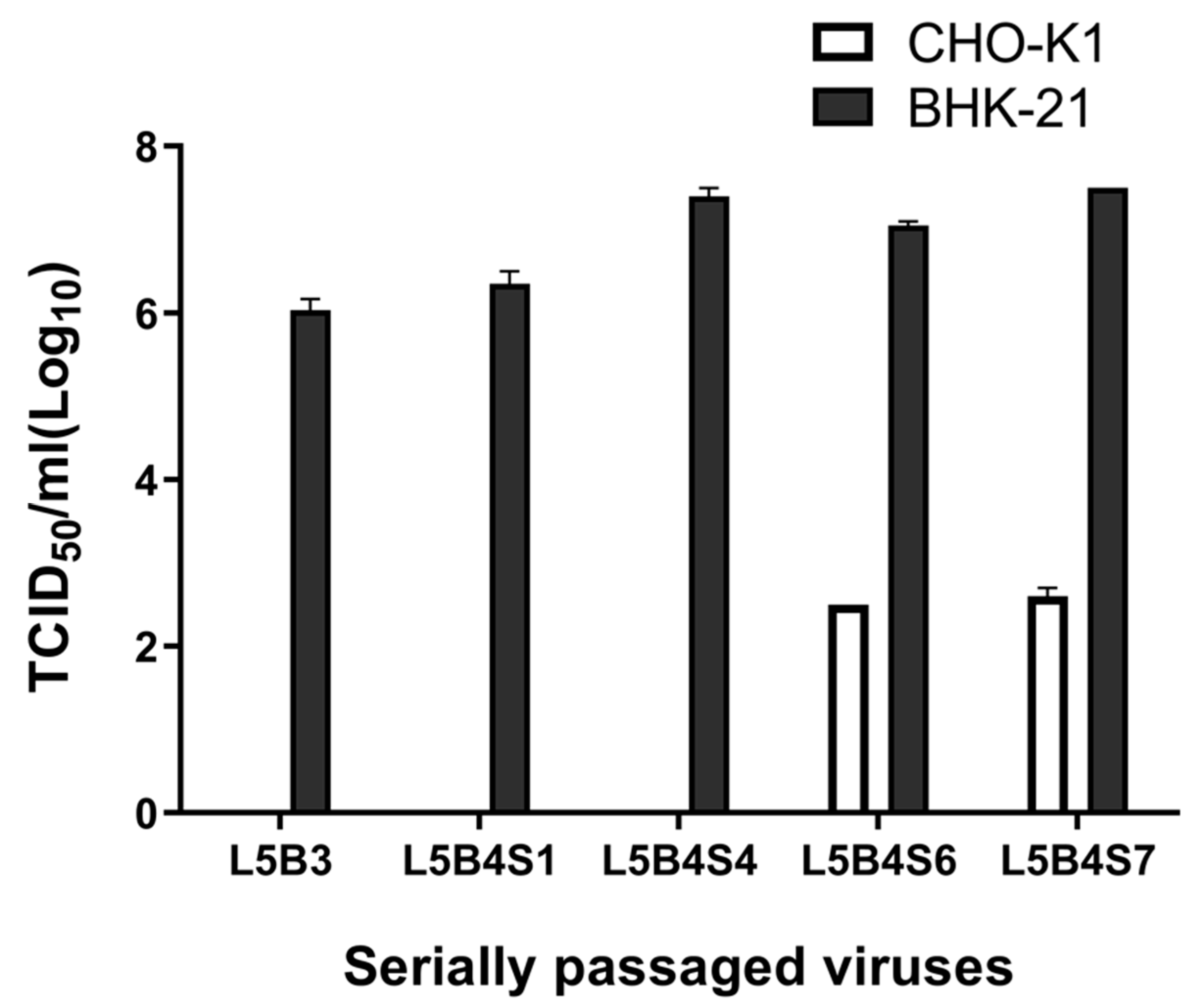
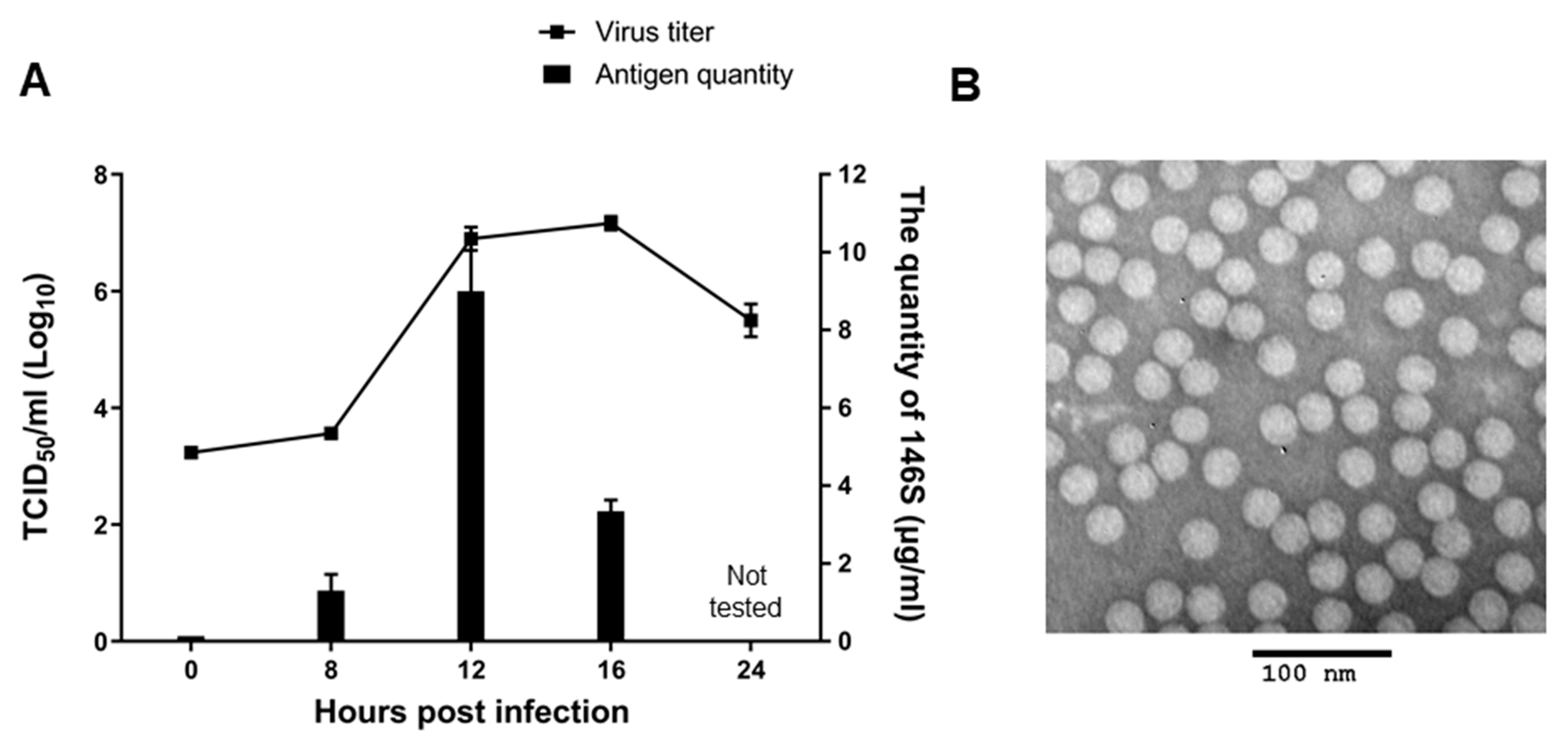
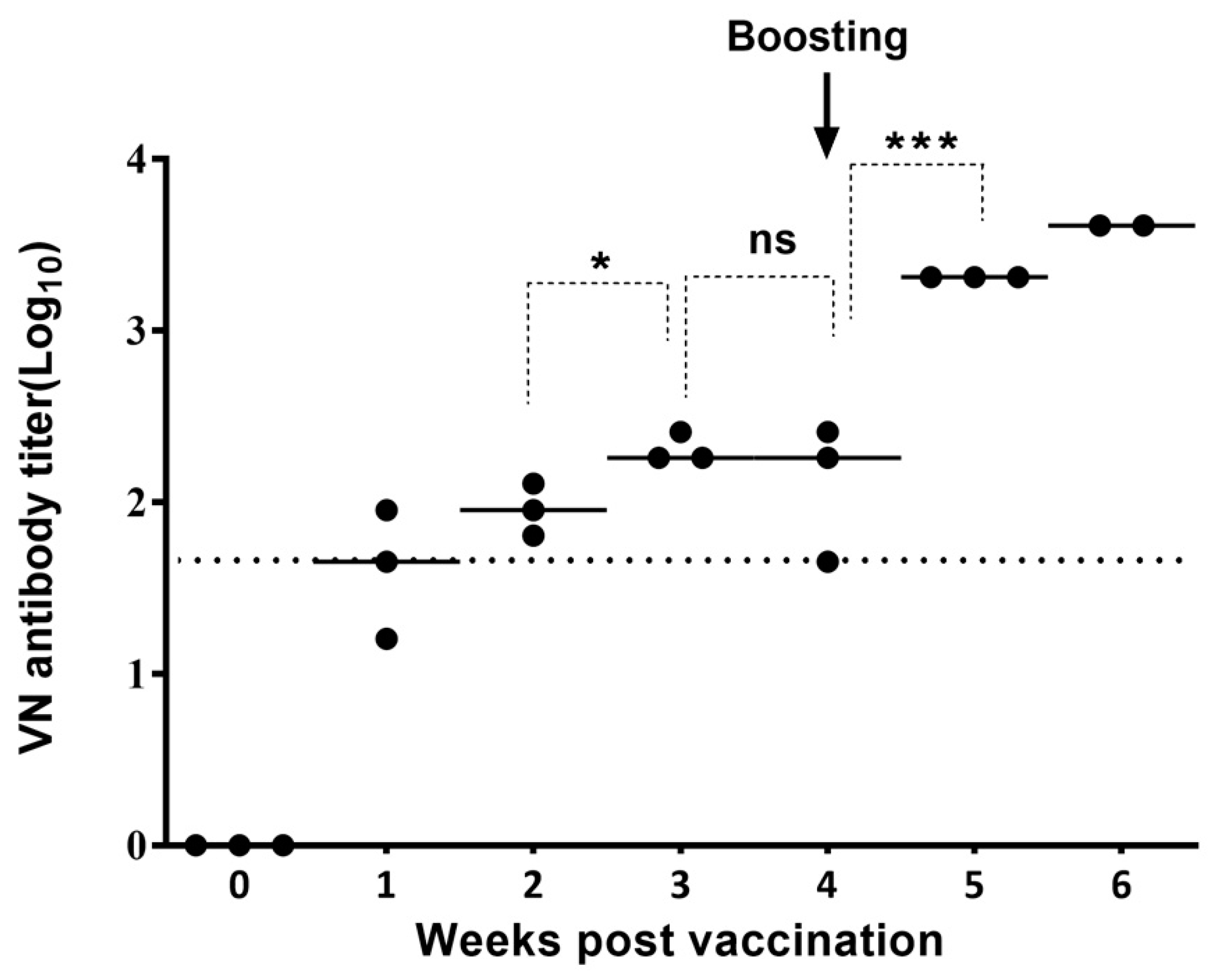
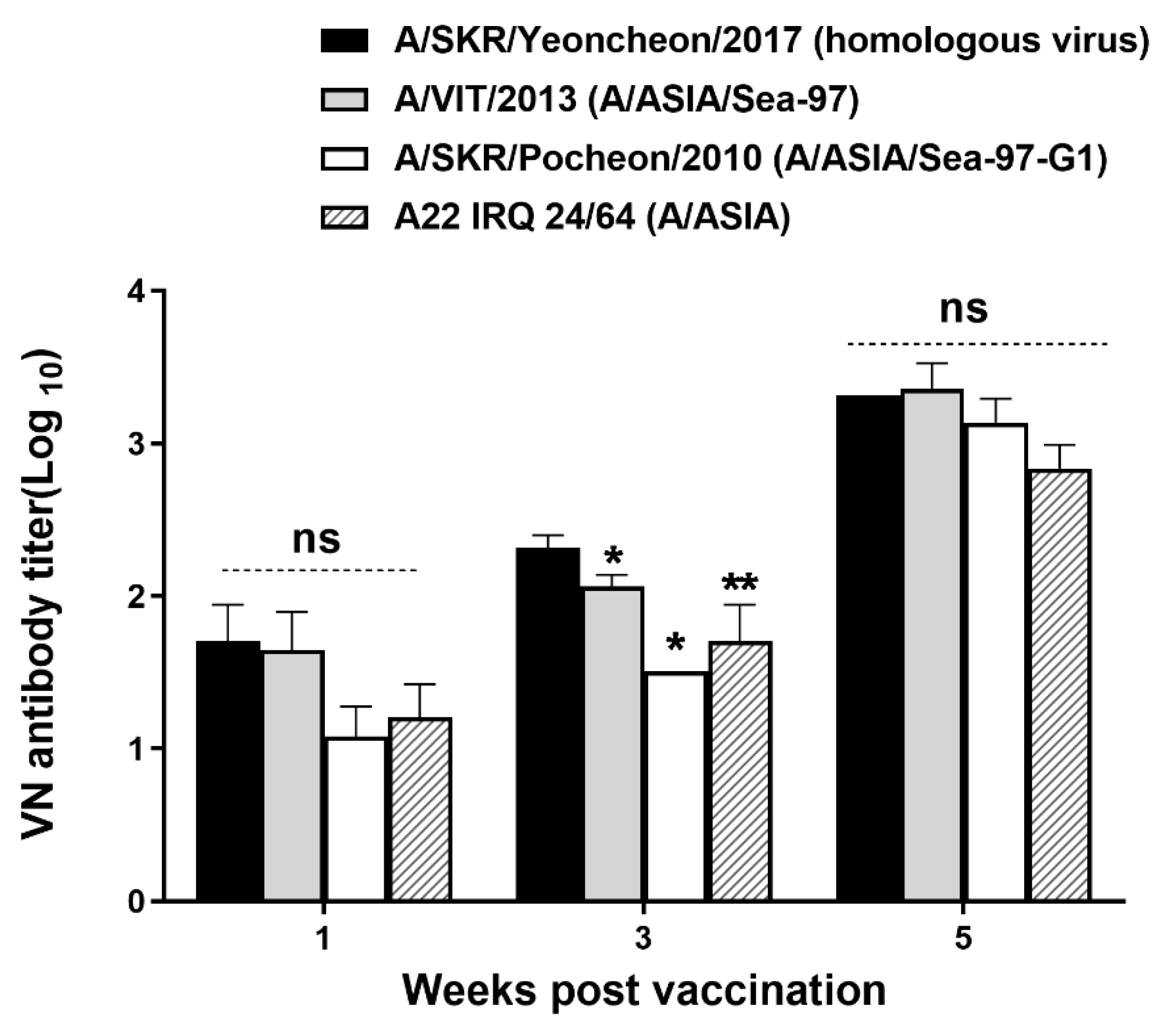
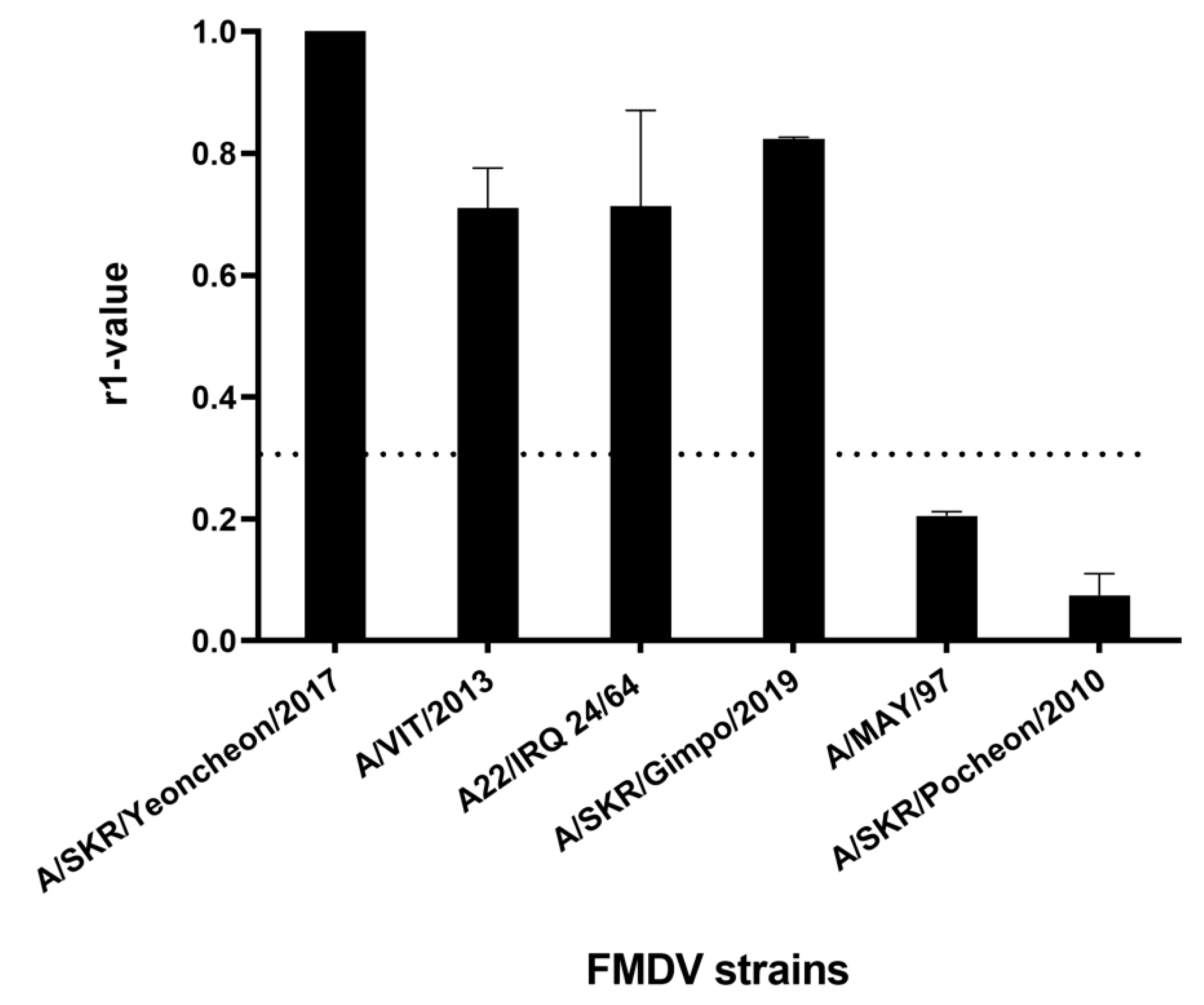

| Virus a | Virus Titer in Two Cell Types (TCID50/mL) | Amino Acid Substitutions in the P1 d | ||||
|---|---|---|---|---|---|---|
| BHK-21 | CHO-K1 b | VP2 | VP1 | |||
| 80 | 82 | 131 | 42 | |||
| Wild-Type | NT c | NT | E | E | E | K |
| Plaque-purified A-1 | 1.2 × 108 | 5.0 × 102 | · | K | · | · |
| Plaque-purified A-2 | 2.0 × 107 | 3.1 × 102 | · | K | G | T |
| Plaque-purified A-3 | 1.2 × 107 | 3.1 × 102 | G | · | K | · |
| Injection | Animal No. | Maximum Clinical Score (DPC of the First Detection) a | Maximum Amount of Viremia b (DPC of the First Detection) | VN Antibody Titer (log10) at 0 DPC |
|---|---|---|---|---|
| Vaccine | 1 | 2 (7) | 2.7 ± 0.7 × 103 (4) | 1.2 |
| 2 | 2 (5) | 1.7 ± 1.0 × 101 (6) | 2.4 | |
| 3 | Neg c | Neg | 2.3 | |
| 4 | Neg | Neg | 2.4 | |
| PBS | 5 | 10 (3) | 1.8 ± 0.5 × 105 (2) | <0.9 |
| 6 | 10 (3) | 2.5 ± 0.4 × 105 (4) | <0.9 | |
| 7 | 10 (3) | 4.5 ± 0.02 × 104 (2) | <0.9 |
Publisher’s Note: MDPI stays neutral with regard to jurisdictional claims in published maps and institutional affiliations. |
© 2021 by the authors. Licensee MDPI, Basel, Switzerland. This article is an open access article distributed under the terms and conditions of the Creative Commons Attribution (CC BY) license (http://creativecommons.org/licenses/by/4.0/).
Share and Cite
Hwang, J.-H.; Lee, G.; Kim, A.; Park, J.-H.; Lee, M.J.; Kim, B.; Kim, S.-M. A Vaccine Strain of the A/ASIA/Sea-97 Lineage of Foot-and-Mouth Disease Virus with a Single Amino Acid Substitution in the P1 Region That Is Adapted to Suspension Culture Provides High Immunogenicity. Vaccines 2021, 9, 308. https://doi.org/10.3390/vaccines9040308
Hwang J-H, Lee G, Kim A, Park J-H, Lee MJ, Kim B, Kim S-M. A Vaccine Strain of the A/ASIA/Sea-97 Lineage of Foot-and-Mouth Disease Virus with a Single Amino Acid Substitution in the P1 Region That Is Adapted to Suspension Culture Provides High Immunogenicity. Vaccines. 2021; 9(4):308. https://doi.org/10.3390/vaccines9040308
Chicago/Turabian StyleHwang, Ji-Hyeon, Gyeongmin Lee, Aro Kim, Jong-Hyeon Park, Min Ja Lee, Byounghan Kim, and Su-Mi Kim. 2021. "A Vaccine Strain of the A/ASIA/Sea-97 Lineage of Foot-and-Mouth Disease Virus with a Single Amino Acid Substitution in the P1 Region That Is Adapted to Suspension Culture Provides High Immunogenicity" Vaccines 9, no. 4: 308. https://doi.org/10.3390/vaccines9040308
APA StyleHwang, J.-H., Lee, G., Kim, A., Park, J.-H., Lee, M. J., Kim, B., & Kim, S.-M. (2021). A Vaccine Strain of the A/ASIA/Sea-97 Lineage of Foot-and-Mouth Disease Virus with a Single Amino Acid Substitution in the P1 Region That Is Adapted to Suspension Culture Provides High Immunogenicity. Vaccines, 9(4), 308. https://doi.org/10.3390/vaccines9040308







